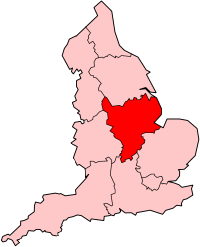Nottingham to Lincoln Line
| Nottingham to Lincoln Line | |
|---|---|
|
A East Midlands Trains class 153 at Lincoln | |
| Overview | |
| Type | Heavy rail |
| System | National Rail |
| Status | Operational |
| Locale |
Lincolnshire Nottinghamshire Leicestershire East Midlands |
| Termini |
Nottingham 52°56′50″N 1°08′48″W / 52.9471°N 1.1467°W Lincoln Central 53°13′35″N 0°32′23″W / 53.2263°N 0.5398°W |
| Stations | 13 |
| Operation | |
| Opened | 4 August 1846 |
| Owner | Network Rail |
| Operator(s) |
East Midlands Trains East Coast |
| Rolling stock |
Class 43 "HST" Class 153 "Super Sprinter" Class 156 "Super Sprinter" Class 158 "Express Sprinter" Class 222 "Meridian" |
| Technical | |
| Number of tracks | Two |
| Track gauge | 4 ft 8 1⁄2 in (1,435 mm) |
| Electrification | 1,435 mm (4 ft 8 1⁄2 in) standard gauge |
| Operating speed | 60 mph (100 km/h) maximum |
| Nottingham to Lincoln Line |
|---|
Legend |
The Nottingham to Lincoln Line is a railway line in central England, running north-east from Nottingham to Lincoln.
History
The Nottingham to Lincoln line was built by the Midland Railway and engineered by Robert Stephenson.[1] The contractors for the line were Craven and Son of Newark and Nottingham[1] who also built many of the stations. Lincoln railway station was built by the contractor Mr. Burton of Lincoln. The line was inspected by General Pasley on 31 July 1846 and opened on 4 August 1846.
Originally the line ended at Lincoln Midland station (later renamed St. Marks) which was built as a terminus. The line was later extended to a junction just east of Lincoln Central railway station (the former Great Northern station), enabling through running from Nottingham to the South Humber ports and Cleethorpes. This extension led to over a hundred years of pedestrian and driver frustration in central Lincoln because there were two mainline level crossings on the High Street within 350 metres, resulting in congestion and traffic chaos. Lincoln St. Marks station was closed (along with its High Street crossing) in the mid-1980s when a diversionary curve was laid to allow services from Nottingham to enter Lincoln Central. The old station building is now part of a shopping centre and houses Lakeland.
Most passenger trains were taken over by diesel units from 14 April 1958, taking about an hour between the two cities.[2]
Current operations
Passenger services on the line are provided by East Midlands Trains, using a mix of mainly Class 156 diesel multiple units, Class 158 diesel multiple units, and pairs of Class 153 diesel multiple units. At certain times Class 156 and Class 153 trains run coupled together. Many trains on this route continue southward from Nottingham to Leicester via the Midland Main Line. Some trains call at Newark North Gate (this is generally the first two and last two trains of the day) by running down the spur at the side of the East Coast Main Line and then reversing back again. Many trains also run between Newark North Gate and Lincoln Central throughout the day, usually timed to provide connections to London Kings Cross and other stations on the East Coast Main Line. Every other hour this service continues to Grimsby from Lincoln Central, with the first and last trains of the day continuing to Cleethorpes. Summer Sundays see a scheduled Newark NG - Lincoln Central - Cleethorpes service. As of 22 May 2011 East Coast now runs one train a day from London to Lincoln.
The line between Newark and Lincoln is currently only cleared for 60-mile-per-hour (100 km/h) speeds. Nottinghamshire County Council has paid for a study into 90-mile-per-hour (140 km/h) running.[3]
The line serves the following places.
- Nottingham
- Carlton
- Burton Joyce
- Lowdham
- Thurgarton
- Bleasby
- Fiskerton
- Rolleston
- Newark-on-Trent
- Collingham
- Swinderby
- North Hykeham
- Lincoln
Service
The service is generally hourly Monday-Saturday with a less frequent service on Sunday. The first trains usually depart on Sundays in either direction during mid-afternoon, giving no morning Sunday service. One train daily on a Monday to Saturday runs along the line from Lincoln Central to London St. Pancras in the morning, and from London St. Pancras back to Lincoln Central in the evening. It only calls at the busier stations along the line, namely Collingham, Newark Castle, Lowdham (evening journey only) and Nottingham. The train travels along the Midland Main Line for the Nottingham - London portion of the journey. There is also one return train a day run by East Coast from Lincoln to London King's Cross which leaves/joins the Nottingham to Lincoln line at the flat crossing with the ECML just north of Newark North Gate station.
References
- 1 2 "Opening of the Nottingham and Lincoln Railway". Lincolnshire Chronicle. England. 7 August 1846. Retrieved 2 March 2016 – via British Newspaper Archive. (subscription required (help)).
- ↑ Railway Magazine June 1958 p. 432
- ↑ "90mph plan to slash rail times". Lincolnshire Echo. Northcliffe Media. 8 April 2008. Retrieved 18 February 2012.
Coordinates: 53°04′36″N 0°50′20″W / 53.0767°N 0.8390°W

